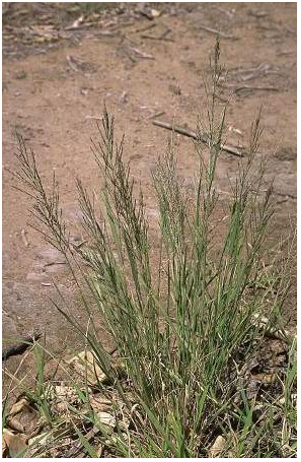
|
|
|
|

|
|||
|
|
|||
|
|
|||
Sprangletop has become increasingly widespread in Arizona mostly because of its growth habits and tolerance to many commonly used herbicides. It is in the Leptochloa genus which is derived from the Greek words leptos (thin) and chloa (grass). There are more than 150 species of sprangletop worldwide but only three in Arizona and two in Yuma County. The two that are the most common in the low desert are Mexican Sprangletop, which is Leptochloa uninervia and Red Sprangletop, Leptochloa filiformis. A third species, Bearded Sprangletop, Leptochloa fascicularis, is more common at higher elevations of 1500 feet or higher. It is not uncommon to find both Red and Mexican Sprangletop in the same field and it is not hard to distinguish them when they are side by side. Red Sprangletop has a light green leaf blade which is similar in width to watergrass and barnyardgrass. It has very fine hairs and very small and fine branches and spiklets. It also has a long membranous ligule. The name Red refers to the leaf sheath which is characteristically red, rather than the seed head. Mexican Sprangletop has a thinner leaf blade which is darker green or grayish in color and similar in appearance to common bermudagrass. The seed head is distinctly coarser than that of Red Sprangletop. Side by side, leaf color and size of the seed make it easy to distinguish these two. Both of these grasses are classified as summer annuals but they grow more like perennials in the low desert. Sprangletop does very well in the hottest part of the summer and typically germinates from seed during the hottest period between July and September. Once established, however, it often survives through the cold winter months. It grows into clumps that often appear to be dead during the winter. New shoots commonly grow from these established crowns the next season. When this occurs, preemergent herbicides such as Trifluralin or Prowl are ineffective. Some Sprangletop plants stay green and grow through the winter. Many of the postemergence, grass specific herbicides that control many grasses are ineffective on Sprangletop. This also has contributed to the spread of these weeds. Sethoxydim (Poast) and Fluazifop (Fusilade) do not control either Red or Mexican sprangletop. Only Clethodim (Select Max, Select, Arrow and others) is the only one of these grass herbicides that is effective and only at the highest labeled rates. Two applications are often necessary to achieve season long control. |
|||
| Back | |||
|
For questions or comments on any of the topics please contact Marco Pena at the Yuma Agricultural Center.
|
|||
|
Home |
Cotton | Veggies |
Forages | Grains
| Citrus |
Crop x Crop Insects | Diseases| Weeds | Pesticides | Economics | News | Weather | Research | Photos | Contacts | General Info. Copyright © 2001 University of Arizona, College of Agriculture and Life Sciences Webmaster: Al Fournier (acis@ag.arizona.edu) |
|||

